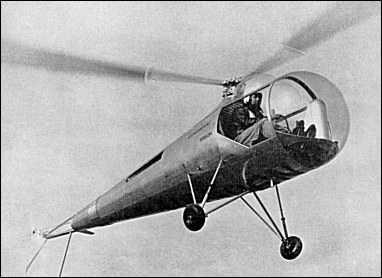
| Brantly B-2 / YHO-3 1946 |  |
 |

| Brantly B-2 / YHO-3 1946 |  |
 |
|
In 1949 the Army procured five examples of the Brantly Model B-2 light helicopter for evaluation in the observation role. The type, which had first flown in February 1953, was a small and simple piston-powered aircraft originally intended for the projected 'personal helicopter' market envisaged during the early 1950s. The five machines obtained by the Army (serials 58-1492 through -1496) were designated YHO-3 and tested at both Fort Rucker and the Naval Air Test Center at Patuxant River, Maryland. The aircraft was ultimately judged to be too small to be of practical military use, however, and all five examples were eventually returned to the manufacturer. S.Harding "U.S.Army Aircraft since 1947", 1990
In 1943, N. P. Brantly began the design of a lightweight helicopter, built and flown in 1946 under the designation Brantly B-1. Like many contemporaries, Brantly used a co-axial twin-rotor configuration to overcome torque effects, but soon realised that his design was too heavy and complicated to appeal to the private pilot. An improved Brantly B-2, of single main rotor and anti-torque tail rotor configuration, was first flown on 21 February 1953, and a further improved second prototype flew on 14 August 1956. This was to enter production in 1958. Changing fortunes have resulted in several different owners of the original Brantly interests, but this emphasises a wide appreciation of a good product, and of a steady demand for it. Michael K. Hynes is the present owner of the type certificates, and he established Brantly-Hynes Helicopter Inc. on 1 January 1975, initially to provide product support for the large number of Brantly helicopters in use. He subsequently started up a production line for the B-2B, and also the larger Model 305. The Model B-2B has a three-blade main rotor and two-blade rotor, an all-metal fuselage structure, and can operate with skid, wheel or float landing gear. Side-by-side two-seat accommodation is provided in an enclosed cabin, and dual controls are standard. The Avco Lycoming powerplant is mounted vertically in the fuselage, just aft of the cabin. D.Donald "The Complete Encyclopedia of World Aircraft", 1997
On 23 December 1994, Brantly International obtained the type certificates for the Brantly B-2B and 305 helicopters from Japanese-American businessman James T Kimura's Brantly Helicopter Industries, which had acquired them in May 1989. In 2002, Brantly employed 40 in its 2,790 ha facility. BRANTLY B-2B TYPE: Two-seat helicopter. PROGRAMME: Developed from coaxial twin-rotor B-1 by Newby ╬ Brantly. First flight (B-2) 21 February 1953; FAA certification 27 April 1959. Total of 194 B-2s and 18 B-2As (with additional headroom) produced between 1960 and 1963. Improved Model B-2B with metal rotor blades and fuel-injected Lycoming IVO-360-A1A engine certified 1 July 1963; total of 165 built between 1963 and 1967 (company owned by Gates Learjet from 1966) and a further one (as H-2) in 1975 by Brantly-Hynes Helicopter. Brantly Helicopter Industries (┬HI) took over manufacturing and marketing rights and production facilities in 1989. First new-build B-2B (N25411 c/n 2001) flew 12 April 1991; three built under this name. Production continues under Brantly International, which received FAA production certificate on 19 July 1996. CUSTOMERS: Total of 27 of current series (including BHI) registered by mid-2003. Notified deliveries were two in 1998, none in 1999, six (to China) in 2000, two in 2001 and two in 2002, including one to China. Total of 14 remained registered in USA at August 2002, and one in Australia. (Some 80 from earlier production remain registered in USA.) COSTS: US$170,000 basic equipped (2003). Direct operating cost US$80 per hour (2003). DESIGN FEATURES: Simple design, with blown main transparency and constant-taper fuselage. Double-articulated three-blade main rotor with pitch-change and flapping hinges close to hub and flap/lag hinges at 40% blade span; symmetrical, rigid, inboard blade section with 29% thickness/chord ratio, outboard section NACA 0012; outer blades quickly removable for compact storage; rotor brake standard; two-blade tail rotor mounted on starboard side, with guard. Transmission through automatic centrifugal clutch and planetary reduction gear. Bevel gear take-off from main transmission, with flexible coupling to tail rotor drive-shaft. Main rotor/engine rpm ratio 1:6.158; tail rotor ratio 1:1. Main rotor minimum speed 400 rpm; maximum 472 rpm. FLYING CONTROLS: Conventional and manual; small fixed tailplanes on port and starboard sides of tailcone. STRUCTURE: Semi-monocoque fuselage with alloy-stressed skin. Inboard rotor blades have stainless steel leading-edge spar; outboard blades have extruded aluminium spar; polyurethane core with bonded aluminium envelope riveted to spar. All-metal tail rotor blades. LANDING GEAR: Fixed skid type with oleo-pneumatic shock-absorbers; small retractable ground handling wheels, size 10x3.5, pressure 4.12 bar; fixed tailskid. Optional inflatable pontoons attach to standard skids for over-water operation. POWER PLANT: One 134kW Textron Lycoming IVO-360-A1A flat-four air-cooled piston engine, mounted vertically. Fuel contained in two interconnected bladder tanks behind cabin, total capacity 117 litres of which 115 litres are usable. Oil capacity 6.9 litres. ACCOMODATION: Two, side by side in enclosed cabin; forward-hinged door on each side. Dual controls and cabin heater standard. Ground accessible baggage compartment, maximum capacity 22.7kg in forward end of tailcone. SYSTEMS: 60A alternator. AVIONICS: To customer choice: GPS is standard. Jane's All the World's Aircraft, 2004-2005
- When Brantly was taken over by Hynes, the B-2 became the Brantly-Hynes B-2. It continued in production until 1994. - Brantly also developed the 305, a larger, five-seat helicopter based on the B-2. - Float, skid or wheeled landing gear was an option on all B-2s. - James T. Kimura was the third owner of the B-2 type certificate, and delivered his first B-2B on 25 August 1990. - British Executive Air Services acquired a production licence for the B-2. - In 1992, a B-2B cost US$120,000 to US$135,000 depending on equipment fit.
|